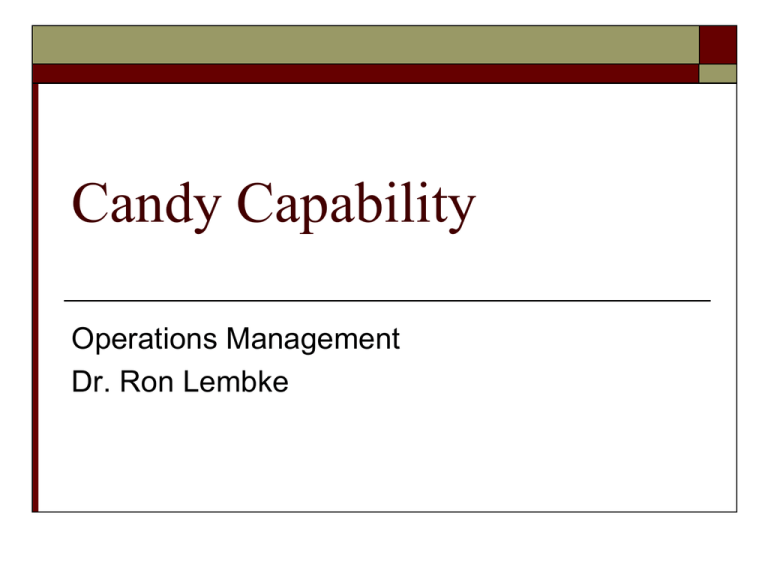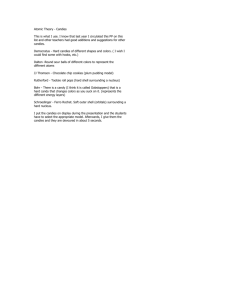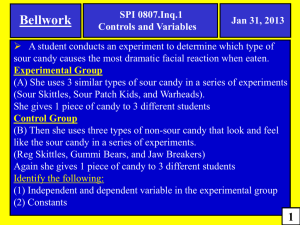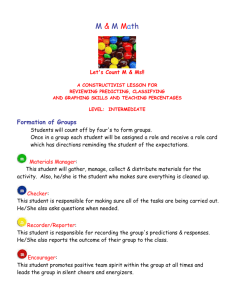Total Quality Management
advertisement

Candy Capability Operations Management Dr. Ron Lembke Tolerance Limits for food? Underfilling who would notice? Overfilling – would anyone care? Packaged Goods What are the Tolerance Levels? What we have to do to measure capability? What are the sources of variability? Production Process Make Candy Make Candy Make Candy Mix Package Put in big bags Wrong wt. Wrong wt. Make Candy Mix % Make Candy Make Candy Candy irregularity Weighing Package and all candies Before placing candy on scale, press “ON/TARE” button Wait for 0.00 to appear If it doesn’t say “g”, press Cal/Mode button a few times Write weight down on form Candy colors 1. 2. 3. 4. 5. 6. 7. Write Name on form Write weight on form Write Package # on form Count # of each color and write on form Count total # of candies and write on form (Advanced only): Eat candies Turn in forms and complete wrappers Your Job Write down package # Optional: Weigh package and candies, all together, in grams and ounces Write down weights on form Open package, count total # candies Count # of each color Write down Eat candies Turn in form and empty complete wrappers for weighing Grams or Ounces? The effects of rounding 25.00 0.80 24.00 g - rounded oz - rounded 23.00 0.7 Ounces 0.70 Rounded Weight - Ounces Rounded Weight - grams 22.00 21 grams 21.00 20 grams 20.00 0.6 Ounces 0.60 19 grams 19.00 18 grams 18.00 17.00 0.50 14.5 15.0 15.5 16.0 16.5 17.0 17.5 18.0 18.5 19.0 Original Weight in grams 19.5 20.0 20.5 21.0 21.5 22.0 22.5 Peanut Candy Weights Avg. 2.18, stdv 0.242, c.v. = 0.111 Peanut Individuals 9 8 7 6 Count 5 4 3 2 1 0 1.5 1.6 1.7 1.8 1.9 2 2.1 2.2 2.3 Mass (g) 2.4 2.5 2.6 2.7 2.8 2.9 3 Plain Candy Weights Avg 0.858, StDev 0.035, C.V. 0.0413 Individual Plain Candies 16 14 12 10 8 6 4 2 0 0. 78 0. 79 0. 8 0. 81 0. 82 0. 83 0. 84 0. 85 0. 86 0. 87 0. 88 0. 89 0. 9 0. 91 0. 92 0. 93 0. 94 0. 95 0. 96 0. 97 Count Mass (g) Mini Candy Weights Avg 0.288, StDev 0.020, C.V. 0.070 M&M Mini Individual Candy Weights 30% 25% Percentage 20% 15% 10% 5% 0% 0.23 0.24 0.25 0.26 0.27 0.28 0.29 Weight (in grams) 0.3 0.31 0.32 0.33 0.34 Peanut Color Mix Brown 17.7% Yellow 8.2% Red 9.5% Blue 15.4% Orange 26.4% Green 22.7% website 20% 20% 20% 20% 10% 10% Plain Color Mix Brown Yellow Red Blue Orange Green Class 12.1% 14.7% 11.4% 19.5% 21.2% 21.2% website 30% 20% 20% 10% 10% 10% So who cares? Dept. of Commerce National Institutes of Standards & Technology NIST Handbook 133 Fair Packaging and Labeling Act NIST Fines Don’t get caught It’s embarassing You’ll look dumb How Many Servings? 264.8g /36g = 7.35 servings 267.9g /45g = 5.95 servings Not for Retail Sale Why Not? •Ingredients •Nutritional information •Peanut/allergy information •Need room for cute pics •Process variability? Acceptable? Sampling Plans for Category A Package Weight “Not Labeled for Individual Retail Sale” If individual is 18g MAV is 10% = 1.8g Nothing can be below 18g – 1.8g = 16.2g Too Much Variability 25% 20% 15% 10% 5% 0% 15 15.5 16 16.5 17 17.5 18 18.5 19 19.5 10.9% of sample below 16.2g! 20 20.5 21 21.5 22 22.5 Avg= 17.57, stdev 1.42 Suppose they wanted to Stated weight = 18g, MAV = 16.2g Suppose want 99.7% chance nothing below MAV Set the average to be 3σ above MAV σ = 1.42g, so set Avg = 16.2 + 3*1.42 = 20.46 You pay for 18g, they give you 20.46g! 13.7% Free! They have to give away 1/7th of the candy! Clearly, they aren’t going to do this! Summary Many reasons M&M’s “Not for Individual Sale” Process variability seems to be an important one, if not the major one Process variability is a very important consideration for companies. BTW, one bag was 223.6g < 264.8











